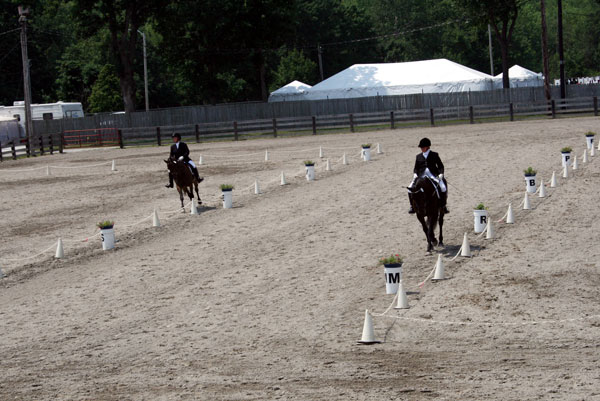Last week a friend I’ve been coaching rode a test while I read for her. I guess I should have done a better job of describing the ideal protocol before the test starts because she rode her warm-up round about as far from the dressage ring area as she could, hugging the perimeter rail. Sure enough, during the test, the horse had several OMG moments, flying sideways away from the rail.

None of that had happened when we practiced the tests at home, but there we only had jump rails for corners plus the letter pylons. Although the mare had now shown in a handful of tests she still hadn’t quite figured that the white fence rail was her friend. For her second warm-up round I told the rider to go as close to the ring, letters, decorative plants and judge’s box as possible. Sure enough, the second test was without incident and 9 percentage points higher than the first test! Both horse and rider learned a lot, and I was particularly proud of the rider about how she made adjustments as she went along, both during the warmup and the test.
Presumably, since the fence around a dressage ring is so low, a horse shouldn’t be all that respectful of it. However, I’ve seen horses whose usual job is jumping figure out the low dressage rail quickly and treat it very much like they do a normal high ring rail. Most horses I’ve worked with that might shy or act up outside the dressage ring stay close to the rail inside the ring after they’ve shown a few times and rarely spook there, as if the rail provides a safety zone.
This even seems true with chain arenas vs. dressage arenas with a solid rail, however low or high. I know most riders don’t like chain rings, but I’ve never had a problem with them. I was also taught very early to maintain control of my horse’s outside shoulder, and “shoulder-fore is your friend” is a mantra that runs through my head when I ride a test and comes out of my mouth when I teach and coach.
It’s pretty natural for a horse to follow an established line, even if it’s little more than a line in the sand. Notice how horses will often follow the same line through a pasture until it’s worn down. At the start of a day of judging, with freshly prepared footing, I always hope the first horse down the center line will be as straight as possible, for the sake of those who follow him. I’ve noticed that if the first horse drifts to one side or draws a squiggle with his feet, the horses that follow him will often drift or weave the same way as well.











